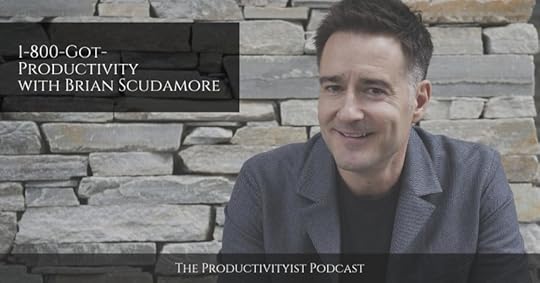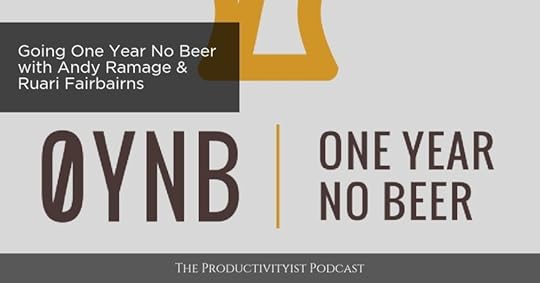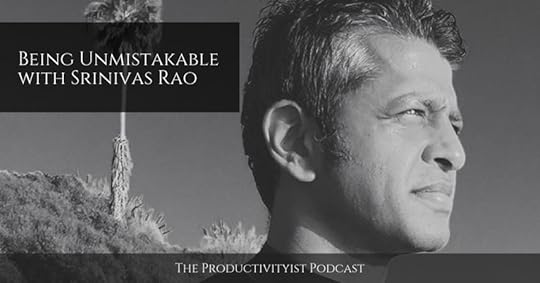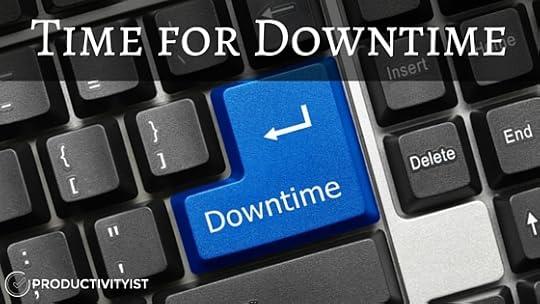Mike Vardy's Blog, page 69
August 22, 2016
The Productivityist Podcast: Lee Caraher

On this episode of the podcast, I speak with Lee Caraher. Lee’s a CEO, an author, and an acclaimed communication strategist known for her practical solutions to big problems.
We talk about the difference between millennials and other generations in terms of work habits and how to manage them. We also dive into other productivity practices such as handling email after hours and one of my favourite topics..setting boundaries.
Relevant Links
Blog | Lee Caraher
Books | Lee Caraher
5 Tips for Handling After-hours Email | Lee Caraher
Productivity Tools | Lee Caraher
LeeCaraher (@LeeCaraher) | Twitter
If you enjoy The Productivityist Podcast I’d appreciate a rating and review in iTunes or your podcasting platform of choice. It helps people find the show easier and will help me make improvements on the show by seeing what you have to say.
Want to help the show even more? Then become a patron The Productivityist Podcast through our Patreon campaign! Check out The Productivityist Podcast’s Patreon page and take a look at all of the perks – available only to Patreon supporters!
The post The Productivityist Podcast: Lee Caraher appeared first on Productivityist.
August 15, 2016
The Productivityist Podcast: Brian Scudamore

On this episode of the podcast I speak with Brian Scudamore, the founder and CEO of O2E Brands. O2E Brands is the banner company for 1–800-GOT-JUNK?, WOW 1 DAY PAINTING, You Move Me, and Shack Shine. Starting with one truck and a great idea, Brian grew 1–800-GOT-JUNK? into one of North America’s most successful companies and he’s poised to do the same with his three newest ventures.
We talk about how he built his brand, do a deeper dive into a tactic he calls “going dark” that boosts his productivity, how he works at keeping things uncluttered (fitting considering the company he founded), and other strategies he employs to stay on top his game.
Relevant Links
O2E Brands
1–800-GOT-JUNK?
Smarter Faster Better by Charles Duhigg
Brian Scudamore | LinkedIn
Brian Scudamore (@BrianScudamore) | Twitter
If you enjoy The Productivityist Podcast I’d appreciate a rating and review in iTunes or your podcasting platform of choice. It helps people find the show easier and will help me make improvements on the show by seeing what you have to say. You can also fill out this survey to help me make the show better.
Want to help the show even more? Then become a patron The Productivityist Podcast through our Patreon campaign! Check out The Productivityist Podcast’s Patreon page and take a look at all of the perks – available only to Patreon supporters!
The post The Productivityist Podcast: Brian Scudamore appeared first on Productivityist.
August 10, 2016
9 Signs You Are On The Verge of Burnout (And What To Do About It)

Today’s guest post is from Johan D’Haeseleer. He’s a writer, speaker and the founder of Extra Time. Johan’s passion is helping others make the most of their time and also helping others reduce their stress levels.
Let’s face it, you’re really busy. Your calendar is packed, yet you are constantly adding more tasks to your to it, right? If you’re completely honest, you feel like you’re losing control. And that feels lousy. Your inbox is overflowing. You’re not fulfilled in your work. You find yourself moving from problem to problem all day long.
Houston, we have a problem.
The good news is that things will get better—if you do something now. You don’t want to wait until complete burnout or you may have to intervene drastically. To help you out, here are nine signs you can keep an eye out for.
1. Your concentration levels are lower than normal.
A simple task takes you longer than usual. You struggle with distraction and you’re unable to focus on the task at hand. You find your attention is being hijacked by all kinds of signals. In these situations, your mental energy is often too low. You need to regain focus. Don’t wait until you are exhausted to do something about it. Go for a walk. Get up from your desk. Talk to some of your coworkers (notice I said talk, not complain. If you find yourself complaining, this is another sign that you are on verge of burnout.)
2. You’re working more hours.
It is not unusual to occasionally work a few extra hours, but it is a problem when you’ve been working more hours for an extended period of time. You may even find yourself calling your family several times saying that you’re going to come home later or that you just need more time.
3. You lack enthusiasm.
When the morning alarm clock chimes, you find yourself frustrated and not looking forward to the day ahead. You press the snooze button several times in the hope that a few more extra minutes make things better.
4. You check your email inbox more than usual.
You find yourself spending more time in email than usual. Instead of accomplishing your tasks, you find yourself checking to see if you have any new email.
5. You’re more fatigued than normal.
Your mental and physical energy levels are noticeably lower than usual. Instead of using the evening to enjoy family life or friends, you find yourself snoozing on the sofa.
6. You’re not feeling confident.
Urgent tasks and important tasks are finding their way into the background. You find your confidence levels wavering and you find yourself unsure about decisions you have made (or need to make).
7. You lack consistency.
You can’t seem to find momentum or establish a healthy rhythm. You have good intentions, but find yourself not doing the things you plan on doing. You start to ignore reminders and items on your to-do list. Instead of going to work out in the morning, you watch television. Instead of reading a book on the train, you browse the web on your phone.
8. You’re very irritable.
You have a shorter fuse than usual and little things bother you. Your responses are petulant in nature and others may even find themselves uncomfortable around you.
9. You find yourself complaining.
When your coworkers complain about an issue, you quickly find yourself joining in. The problem here is that negativity breeds more negativity. When you complain, that negative mindset can carry over to other parts of your life. And when you find yourself complaining a lot, something is definitely wrong.
What You Can Do About Burnout
So what can you do if you notice these warning signs? Most importantly, you should take a break. Recharge your energy levels and sort things out. The great news is that this doesn’t necessarily take a lot of effort. You may need to take a walk or just take the afternoon off. Another important step is to have accountability.
As you think about your problem, you’ll likely conclude that the majority of your feelings of being overwhelmed are related to your work. If you were to become more efficient—or even have less work—that would definitely help, wouldn’t it? Here are some strategies you can use at work to lighten the load.
Quit (Some Of) Your Work
You cannot spend your time on things that are not giving you results. When you stop working on these tasks, you will give yourself extra time. Understandably, this can be a difficult decision to make. We are all creatures of habit. You may even struggle to decide which task(s) you need to stop doing. Trust me, this is time well spent as you’ll save time in the long run. You’ll also free up some valuable mental energy you can use somewhere else.
Saying no is not easy, especially when you have different interests. You may not be sure what you want to focus your attention toward. Take small steps. Rome wasn’t built in a day, right? Make a simple plan. When you have a plan in place, this will help you set boundaries and limits. Best of all, these boundaries can help guide you as to what tasks you should stop doing.
So how can you do this, right?
Take a look at your day and find the areas that are not in alignment with your plan. Take inventory. Think about it. Then eliminate all tasks that are not needed.
Do Less Work
This is not as drastic as the first step. Think about some of the things you do several times a day, week or month? Can you reduce the frequency of these items? Consider holding your weekly meeting every other week. Suddenly, you have thirty minutes more of extra time per week.
Consider using the Pareto principle. The rule states for many events, roughly 80% of the effects come from 20% of the causes. If you apply this rule to what you read, you know 20% of what you read makes up 80% of what you know. You can consume less information online. The eighty/twenty rule applies to just about everything. Don’t hesitate to use it.
Reuse some of Your Work
Do you have work you can reuse? Why not use some of that content on another platform? Let’s say you use images on your website. Why not share them on Instagram as well? Do you have some video on your website? You can upload it to Youtube. When you reuse some of your work, you save yourself time and you can even get better results from your initial efforts.
Batch Your Work
One of the easiest ways to get more done is to batch similar tasks together. This is not working on things simultaneously—that would be multitasking—but rather doing one task after another. As you continue to batch your work, your speed will increase.
Here are a few examples to consider:
You don’t go into your boss’s office five times a day to ask a question, right? Instead, a better way to handle this is to write your questions down and go in once to ask all of your questions.
When you are writing something, don’t write and edit the same time. This will take more time. Instead, write first and then edit later.
Instead of checking into your email inbox ten times a day, you can check it two or three times during the day.
Simplify Your Work
Everything you do is one of three things: an input, an output, or a process. The process is the middle step which includes the work you do turning an input into an output. You can intervene at any of these three points, which creates additional time. Let’s look closer at each area.
Simplify your outputs. In some cases, you may want to set the bar lower. When is a product good enough to be shipped? Some bells and whistles are not necessary and can actually halt progress. When you set limits, this will help you be more effective and efficient.
Simplify your inputs. Can you get the same result with less information? If so, use that approach. When you create something, it is common to overprepare or to spend too much time in research. As a rule of thumb, use the things you know you need for the process of starting (or creating an input), nothing more.
Simplify your process. Look at all of the steps you’re doing and ask yourself whether or not they add value. If they do not add value, remove them from your approach.
Systemize Your Work
You can save time by establishing a systematic approach to the tasks you have to do frequently. For example, checklists are often a helpful way to help you monitor the processes. What is your system to process your inputs? Do you use even though this chart before?
You leave your car keys in the same place to save time, right? This is a simplified form of systemizing. Apply this kind of approach to your work.
Automate Your Work
Taking a systematic process and automating it can save you a lot of time. Before you automate it, simplify the process as much as possible. Make sure that each part of the process is truly required and is controlled. Automating an uncontrolled process will not help you save time.
Here are a couple examples of where automation works well:
Automatic invoicing saves a lot of time and effort.
When you find yourself using the same portions of text, text expanders are very helpful. A simple shortcut can paste a large portion of text into a document.
If This Then That is a useful tool to help save you time. Once you set up a “recipe” you can get an automatic email when it is going to rain, backup photos you post to Facebook automatically, automatically save your contacts to a Google Spreadsheet and much more.
Delegate Your Work
When you delegate tasks or projects to staff or team members, this can give you extra time. The challenge is often that you are the one to decide what to delegate. Not sure how to make a decision? Look at your checklist. Find the items that you keep putting off or you know are not the best fit for your skill set. You should delegate when someone else is better skilled or it is cheaper to have someone else to handle a task.
When a new employee joins your team, you delegate, right? That gives them work to do and also gives you extra time. The problem lies when people only delegate when they don’t have enough time.
Outsource Your Work
In many cases, it is very beneficial to hire some outside assistance. The number of freelancers available worldwide is on the rise. For any area that requires special skills, you can either acquire or outsource. For example, when you design skills are not spectacular, it is better to outsource your layout and web design. This will save you time and you will also have a better overall result.
Do Your Work Faster
There is nothing wrong with working faster in certain areas. I personally learned to read faster by taking this workshop that raised my reading speed from 250 words per minute to 750 words per minute. When I read a longer book, one that is say 55,000 words in length, I now save myself about two and a half hours of my time by reading faster. Another area that is helpful to develop speed is in typing. The faster you type, the more you can communicate. You can save time in this area as well. Both of these skills are well worth the investment.
Wherever you are, whether you are doing well right now or if you are facing burnout, the great news is that you can turn everything around today. Many times, the key is to be intentionally self-aware. When you know there is a problem, then you can start to work on a solution.
How do you handle burnout? Please share your thoughts in the comments.
The post 9 Signs You Are On The Verge of Burnout (And What To Do About It) appeared first on Productivityist.
August 8, 2016
The Productivityist Podcast: The One Year No Beer Challenge

In this episode of the podcast, I not only talk with Andy Ramage and Ruari Fairbairns of One Year No Beer but I also take on one of their challenges.
That’s right. As of recording this episode I went alcohol-free for 90 days.
I dive into that challenge a bit more in an upcoming bonus episode (exclusive to Patreon supporters) but also a little bit in this one. Other than me taking on one of the challenges offered through One Year No Beer I talk to the founders of the movement about why they started it, what the future holds for it, when to start a alcohol-free challenge, and how going alcohol-free can impact your productivity.
This is definitely an interesting episode of the podcast as I’ve not gone down this path before, so I hope you enjoy it!
Relevant Links
OneYearNoBeer // The Ultimate Social Challenge | OYNB
Don’t give up alcohol tomorrow – make it happen today | OYNB
Why Dry Jan could be bad for you | OYNB
Your Guide to Start Meditating – OYNB
How To Stop Drinking – A Little Taster | OYNB
Booze Free Summer Toolkit | OYNB
Limitless: The infinite possibilities of a life free from alcohol | OYNB
Seedlip
OneYearNoBeer (@oynbuk) | Twitter
If you enjoy The Productivityist Podcast I’d appreciate a rating and review in iTunes or your podcasting platform of choice. It helps people find the show easier and will help me make improvements on the show by seeing what you have to say. You can also fill out this survey to help me make the show better.
Want to help the show even more? Then become a patron The Productivityist Podcast through our Patreon campaign! Check out The Productivityist Podcast’s Patreon page and take a look at all of the perks – available only to Patreon supporters!
The post The Productivityist Podcast: The One Year No Beer Challenge appeared first on Productivityist.
August 4, 2016
3 Things To Do When You Feel Ruled By Time

Being split by time is not fun. It is a form of being ruled by time. Unless you step back and really look at the situation, it usually doesn’t feel as if you are having a struggle with time. At least not right away.
Instead, you feel bogged down, tired, and frustrated. The problem with being split by time and then realizing it is that the knee-jerk reaction is to stop doing something altogether.
If you do this you may miss a really good opportunity to make things work. For example, if I had outright quit my job at Costco, there is no way that I would be doing what I’m doing now. There is no way that I would have had the success I’ve had in this new chapter of my life. There is no way that my relationship with time would be the healthiest that it’s ever been.
If you feel split by time, consider the following three variables:
1. Analyze
Take a long look at what your current situation and think about where you want to be. This will mean reviewing what has happened in the past. Think about what you’d like to see happen over the short and long-term. Be realistic and prepare for the lowest common denominator.
For example, I was ghostwriting a lot before I took Productivityist to the next level in early 2014. In fact, I kept ghostwriting up until the middle of 2014 to give myself enough of a financial buffer in case things didn’t go as I had envisioned.
Finances will always be a big concern. They will always be a reason that you don’t jump forward doing something that is too risky. The key is to get all of this information out of your head. Put it in front of yourself so that you can look back and look forward before you make a decision.
2. Strategize
Once you’ve decided what you’re going to spend your time on, more than anything else, you need to plan accordingly. There is no point in strategizing before analyzing because you will still have remnants of doubt and hyperbole rather than the knowledge you have cut off all other options.
You will be able to strategize better when you have as much information as possible in front of you. This will allow you to formulate a plan that you can adjust when needed.
And don’t just develop strategies for today. Develop them for next week, next month, next year, and beyond. If you go forward without a plan in any specific direction, you’ll find yourself moving madly in all directions.
3. Catalyze
Now you need to have one specific trigger that sets your plan into motion. When I decided to quit working at Costco, I knew the catalyst for change would be when I visited my warehouse manager to give notice. I did not go to my direct supervisor – I went straight to the top. The impact this created was far greater than simply writing a note and handing it off to someone with less authority. This wasn’t a slight to my supervisor – I did let him know shortly thereafter – but I wanted to make a statement not to the company but myself.
I needed to know that this was a final decision. I needed to create a catalyst that would spur me forward. There was simply no turning back. I needed to show myself that I was focused, driven, and full of resolve. So when you finally are ready to make a move, make the first move a big one. After over 11 years at Costco, I walked out those giant doors as an employee for the last time in early 2006. The company had given me so many great gifts over the years, including the ability to move across the country and set off a series of events in my life that would lead me to an amazing family, a fulfilling career, and much more. My time at Costco also helped me repair my relationship with myself and improved my relationship with time.
“Until you value yourself, you won’t value your time. Until you value your time, you won’t do anything with it.” M. Scott Peck
But like any relationship, the one I have (and you have) with time always needs work. Hard work. The above quote is from the author of The Road Less Traveled, which is a book I highly recommend. Until I left Costco, I had walked along a well-worn path. I started to add new elements to my life, like performing comedy. But there were still parts of that road that were easy. And I needed them to be.
The post 3 Things To Do When You Feel Ruled By Time appeared first on Productivityist.
August 1, 2016
The Productivityist Podcast: Order and Organization with Rashelle Isip

On this episode of the podcast I’m joined by Rashelle Isip of The Order Expert. Rashelle is a consultant, author, and founder of TheOrderExpert.com, a blog featuring organization, time management and productivity tips, ideas and inspiration to help people lead more balanced lives. She is author of “The Order Expert’s Guide to Time Management” and “How to Plan a Great Event in 60 Days.”
We talk about a wide variety of topics relating to order and productivity, including the importance of saying no, the idea of journaling, simple ways you can stay on track, and more. For Patreon supporters, we even dive into Rashelle’s thoughts on focus.
Relevant Links
The Order Expert – Organizing Blog & Organizing Tips
About | The Order Expert
Why Saying ‘No’ is Important | The Order Expert
Books | The Order Expert
How to Organize a Notebook or Journal | The Order Expert
Blog – Baron Fig
5 Smart Ways to Stay on Schedule | Time Management Ninja
The Order Expert’s Guide to Time Management | The Order Expert
How to Get More Done in a Day | The Order Expert
Rashelle Isip (@theorderexpert) | Twitter
If you enjoy The Productivityist Podcast I’d appreciate a rating and review in iTunes or your podcasting platform of choice. It helps people find the show easier and will help me make improvements on the show by seeing what you have to say. You can also fill out this survey to help me make the show better.
Want to help the show even more? Then become a patron The Productivityist Podcast through our Patreon campaign! Check out The Productivityist Podcast’s Patreon page and take a look at all of the perks – available only to Patreon supporters!
The post The Productivityist Podcast: Order and Organization with Rashelle Isip appeared first on Productivityist.
July 27, 2016
How to Start (and Keep) a Journal that Works for You

In my last post, I dove into how journaling can:
– Deepen your awareness and connection to your work and yourself
– Give you clarity and confidence to make important decisions
– Propel you towards what you want to accomplish
That all sounds fine and dandy, but how exactly do you keep a journal that accomplishes these things?
The good and the bad news is this: There’s no right way to journal.
I can’t offer you a foolproof system or formula to ensure that your journaling practice constantly improves your awareness, confidence, and momentum.
But don’t click that X in the corner just yet! Have I mentioned that I’m an experienced journalist? No, not the newsroom kind of journaling… the notebook kind.
If there were a certificate in notebook journalism, I would hang it with pride above my desk. And, while there’s no such certificate (as far as I know), I do have years of experience. I’m talking trial and error, stopping and starting, progressing and regressing – you get the picture.
Keeping a journal can feel daunting and somehow self-invasive. But you in just a few minutes per day you can reap some unbelievable personal and professional benefits! If I’m not credible enough for you, read about why Mike does it. Mike is a journaling fanatic. And he’s the expert, right?
If you’re still not convinced, you can check out what Forbes, Harvard Business Review, FastCompany, Inc, Entrepreneur, Psychology Today, and Psych Central have to say on the matter.
It’s safe to say that word is spreading about journaling, and the consensus is unanimous: journaling is essential to your productivity and also to your progress.
I’ll assume I’ve convinced you, okay? Now, let’s begin.
Choose Your Set-Up
Everything starts with deciding your medium: digital or paper. Make this decision right off the bat and stick with it. Journaling is a practice of organizing jumbled thoughts, feelings, etc. When you jump back and forth between mediums, it is confusing and totally counterintuitive. So if you want to use paper, go to the next section. If you want to use a digital journal, skip a paragraph and go to that section.
So, you want to use a paper journal.
Your journal doesn’t have to be fancy. As a self-proclaimed notebook journalist, I literally use an 8.5×11” lined notebook. I drool over beautiful journals as much as the next writer, but I’ve found that fancy covers and gold-lined pages intimidate me from “dirtying” them with my imperfect words (especially on the tough days). Use what works for you, but focus on the process of journaling rather than the physical journal itself.
If you’re into the old school pen-and-paper system, check out Mike’s tips on why paper works and how to use a notebook.
Okay, so you’re using a digital journal.
Do yourself a favour and turn off wifi before you start typing (at least at the beginning). Though I’m a proud notebook journalist, when I’m writing on my laptop – which is constantly – I disconnect from online distractions. When you take the time to reconnect with yourself and review your day, airplane mode is your friend.
If you’re pursuing the path of digital journaling, use a writing tool or app you can take offline (I like Word or Pages). Mike’s also written some tips for journaling with Evernote.
I generally steer clear of using my phone or any dictation tools. While these can be easy ways to get things down quickly, they often invite distraction. Plus, since we casually speak thousands of words each day, by the time you sit down to reflect on your day, you’ve already spent your day talking. Writing exercises different parts of the brain than speaking, leading to deeper and more attentive reflection.
Embrace the Blank Page
One of the most important lessons I’ve learned from journaling is that it doesn’t have to sound good. This is good news for me, because most of the time, it doesn’t.
You’re not writing poetry or crafting a business presentation. Your writing is only for you. The important thing is to get your pen to paper (or fingers to keyboard). Don’t give yourself time to second-guess yourself.
If this is a struggle for you (which it initially is for everyone), check out the questions at the end of this post. Or write your own list of questions you’d like to answer each day. This structure prevents you from guessing and planning and directs your energy towards the actual writing part.
Not into prompts or questions? Try writing the first thing that pops into your head, and take it from there. Free writing is a great way to encourage creativity, see where your head’s at, or get more comfortable with writing regularly.
Be Honest with Yourself
Both with free writing and specific prompts, journaling only really works if you open up – especially on the tough days. There’s no doubt that it can be hard to recognize and reflect on your struggles. This is especially true when you’re in the midst of turmoil and feel like you’ve got 100 thoughts spinning around in your brain (and 99 of them are problems).
The hard days are the days you need to journal the most. Get those thoughts out of your head and onto your screen or paper where you can actually see them. This can provide incredible clarity and allow you to tackle one thing at a time.
Some of my favourite journal entries to look back on are from the toughest days. These generally included a lot of scribbles, capital letters, and a few profanities. In reading them, I can understand and appreciate my struggles, vulnerability, perseverance, and progress.
Honest journaling allows you to express what’s happening now so that you can better understand it and know how to deal with it – both now and in the future.
Practice Leads To Habits
There will be days when you won’t feel like writing or you don’t feel you have anything to write about. The key to journaling is to make it a habit – even if for a few minutes each day (preferably at a similar time).
I personally like journaling before I go to bed. This way, it’s not just at the end of the workday, but at the end of my entire day (there’s so much to reflect on outside of work!).
If you had a great day, take a few minutes to celebrate your wins.
If your day felt like an endless struggle and you’re just waiting for it to be over, reflect on what made it challenging. Being specific puts things in perspectives, transforms thoughts and feelings into practical actions, and can shed light on the problem should it arise again in the future.
If nothing particularly eventful happened that day, write that down. (If you notice a series of those notes in your journal, it might be time to incorporate something new into your work, relationships, habits, etc.).
Not sure where to start? Have a conversation with yourself.
How was your day?
Great, now ask yourself how you came to that answer. What factors did you evaluate? Work? Relationships? Health? Personal development?
List these factors and write about how you feel you’re doing each one.
How do you feel (physically, mentally, and emotionally)?
What did you learn? How did you move forward today? (This could relate to knowledge, skills, self-awareness, goals, etc.)
What’s one specific thing you can do to build on this progress tomorrow?
What did you struggle with today?
What’s one specific way to deal with that struggle tomorrow?
As I said in the beginning, there’s no right way to journal. But with time and attention, you can customize this practice to make you more productive – in a way that’s meaningful to who you are and where you want to go.
Start today.
Find a set-up that works for you.
Use prompts or free write to acknowledge and review your thoughts.
Be vulnerable and honest with yourself.
And practice until it becomes a habit (and then keep practicing!)
Meaningful productivity begins with mindfulness.
And mindfulness begins with you.
The post How to Start (and Keep) a Journal that Works for You appeared first on Productivityist.
July 25, 2016
The Productivityist Podcast: The Unmistakable Srinivas Rao

On this episode of the podcast, I chat with my friend Srinivas Rao. Srini is the author of the book Unmistakable: Why Only is Better Than Best and the founder and CEO of Unmistakable Creative. We talk about his book (which I’ve dog-eared to death) and going down the path of becoming unmistakable.
We discuss mastery, habits, systems, goals, in depth. I really enjoyed this discussion and know there are pearls of wisdom strewn throughout that won’t just help you with your productivity. They will also help you forge your own path to unmistakability.
Relevant Links
Unmistakable Creative
Being Unmistakable with Srinivas Rao | The Productivityist Podcast
Mastery by Robert Greene | Amazon
Todd Herman
Mars Dorian
Paul Jarvis
Chris Milk | TED.com
The Art of Non-Conformity by Chris Guillebeau | Amazon
If Everyone Becomes a Non-Conformist, Won’t We All Be Conforming? : The Art of Non-Conformity
Baron Fig | Notebooks for Thinkers
Pre-Order Unmistakable | Bonuses
Srinivas Rao (@UnmistakableCEO) | Twitter
If you enjoy The Productivityist Podcast I’d appreciate a rating and review in iTunes or your podcasting platform of choice. It helps people find the show easier and will help me make improvements on the show by seeing what you have to say. You can also fill out this survey to help me make the show better.
Want to help the show even more? Then become a patron The Productivityist Podcast through our Patreon campaign! Check out The Productivityist Podcast’s Patreon page and take a look at all of the perks – available only to Patreon supporters!
The post The Productivityist Podcast: The Unmistakable Srinivas Rao appeared first on Productivityist.
July 20, 2016
Time for Downtime

Have you ever taken some unannounced time off? Not too long ago, I did.
I didn’t send a newsletter. I didn’t write a thing. I took a weeklong “staycation” and decompressed.
Now that didn’t mean I didn’t do any coaching calls. I took all of them. I did the bare minimum of what I needed to do, because that is what I wanted to do. I wanted some downtime…so I took it.
I normally have lot going on. I always do. Even though my definition of “a lot” has altered over the years. I don’t commit to nearly as much as I did even a year ago.
Part of being productive isn’t doing things all the time or doing all the things. It’s doing the right things – and doing them at the right time whenever possible. And the right thing for me was to take some time off without much of a warning.
“For fast acting relief, try slowing down.” ― Lily Tomlin
Life isn’t a race. We surely aren’t trying to see who gets to the end first. It’s not even something you can really “win” either.
The thing about life is that it goes by so fast that you can end up counting the moments instead of living them. You really understand this once you have children. They develop each and every day. Some of us get to see more of this development – either by choice or by default. Others may only get glimpses of it – also by choice or by default.
I miss moments with my children because I have spent my time in other moments…and that’s okay. The fact I’m aware of this – and that I make sure that I spend my time wisely on both sides of the equation – makes it okay. I’ve put measures and systems in place to assure that how I spend my time counts.
Downtime is the key to achieving that awareness. It improves that sense of understanding and knowing. That’s why you need downtime too– so you can be better during your “uptime” periods.
The post Time for Downtime appeared first on Productivityist.
July 18, 2016
The Productivityist Podcast: Stephan Spencer

On this episode of The Productivityist Podcast, I speak with Stephan Spencer. Stephan is a man of many talents and projects, including hosting The Optimized Geek and writing the book The Art of SEO.
The focus of our conversation is on optimization. And I’m not just talking about search engine optimization (although as a Patreon supporter you will hear about his fascination with that subject matter). We dive into optimizing oneself, deliberate practice, Tony Robbins, the power of automation, and balancing learning with execution.
(Stephan also offers something special for listeners of the podcast, so listen for that!)
Relevant Links
SEO Expert, Author, Professional Speaker | Stephan Spencer
Optimized Geek | About
Platinum Partnership | Tony Robbins
Deep Work: Rules for Focused Success in a Distracted World | Cal Newport
Optimized Geek | Podcast
Unleash The Power Within | Tony Robbins
Marketing Speak | Podcast
Stephan Spencer (@sspencer) | Twitter
If you enjoy The Productivityist Podcast I’d appreciate a rating and review in iTunes or your podcasting platform of choice. It helps people find the show easier and will help me make improvements on the show by seeing what you have to say. You can also fill out this survey to help me make the show better.
Want to help the show even more? Then become a patron The Productivityist Podcast through our Patreon campaign! Check out The Productivityist Podcast’s Patreon page and take a look at all of the perks – available only to Patreon supporters!
The post The Productivityist Podcast: Stephan Spencer appeared first on Productivityist.



